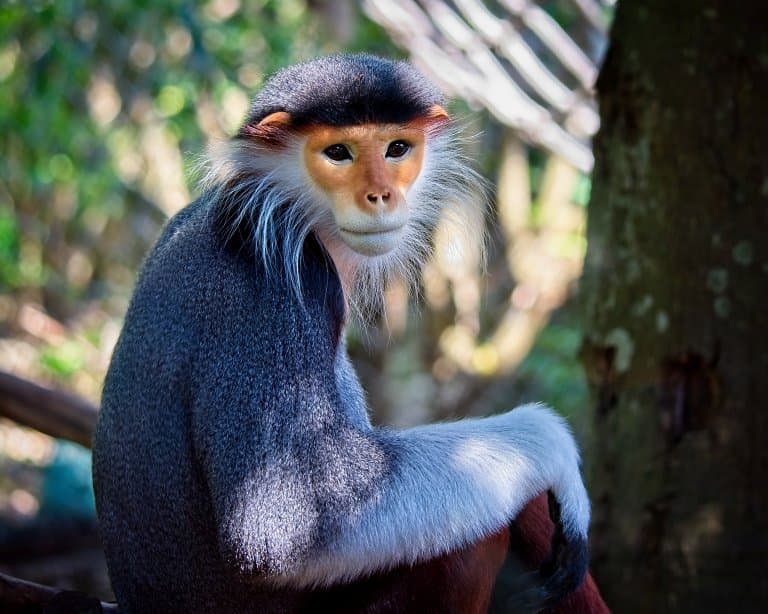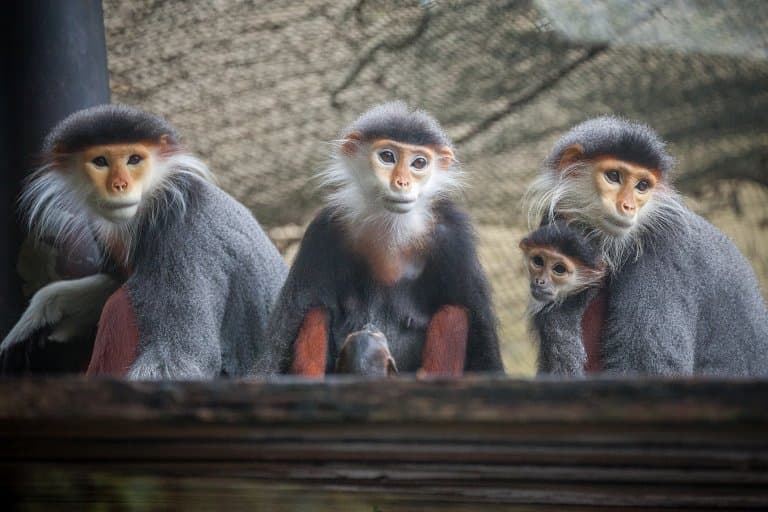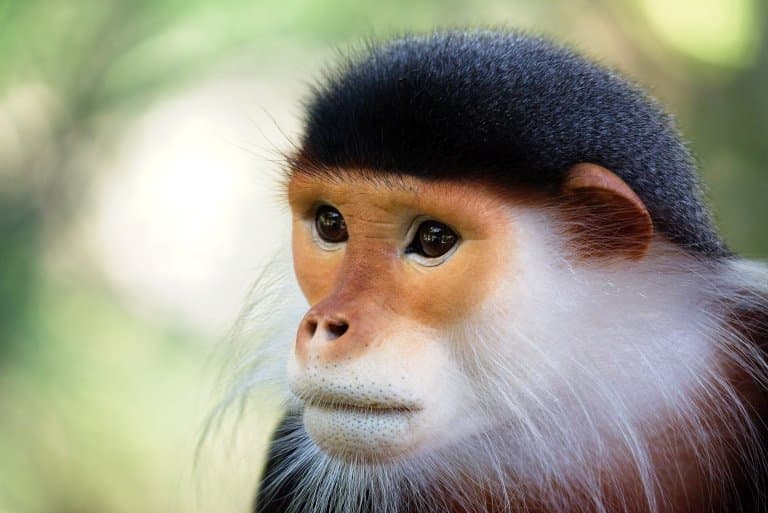Douc Profile
In the ravaged forest canopies of Southeast Asia, there’s a monkey with a face designed to express.
Huge, dark eyes contrast with a creamy muzzle and cheeks, all framed with grandpa whiskers and a neat little haircut.
Douc, or douc langurs aren’t actually langurs at all, they’re critically endangered colobine monkeys that are in dire need of conservation.

Douc Facts Overview
| Habitat: | High canopy forest |
| Location: | Southeast Asia, mainly Vietnam, Cambodia, Laos |
| Lifespan: | Possibly up to 24 years |
| Size: | Around 75cm (30 inches) tall |
| Weight: | 8-11 kg (18-25lb) |
| Color: | Black to grey, with creamy faces and red, black or grey legs |
| Diet: | Mostly leaves, also seeds, fruits and flowers |
| Predators: | Humans, large eagles |
| Top Speed: | Unknown |
| No. of Species: |
3 |
| Conservation Status: |
All species Critically Endangered (IUCN) |
There are 3 species of douc that are all native to Southeast Asia countries, including Laos, Vietnam and Cambodia: the red-shanked douc, black-shanked douc, and gray-shanked douc.
All 3 doucs are long slender monkeys, and the red-shanked douc is among the most colorful of primates.
Doucs aren’t fussy eaters, they’ll spend almost their entire lives way up in the canopy, munching on anything edible – in particular, they diet on leaves, buds, plants and fruit.
They’re interestingly liberal in their societies and the way they look after their young, usually occupying peaceful communities of between 3 and 35 individuals.
Their faces allow for a lot of visual communication, and they have some unique quirks to these displays that set them apart from their grumpy-looking cousins.
Sadly, they are three species in grave danger of extinction, as habitat destruction and fragmentation keep them in decline.
Interesting Douc Facts
1. They eat more or less anything leafy
As primates, we could all be doing better with our diets. Of the roughly 200,000 species of edible plants on Earth, humans routinely eat the same nine species.
Doucs are not nearly as restricted. They will munch on almost anything edible they come across, and have been found to consume leaves from at least 150 species of plant. 1
2. They come and go
Douc monkeys have interesting family dynamics. In a forest world with lots of individuals, primates often have social structures that involve members banding off together and others joining at irregular intervals.
Chimpanzees, orangutans and even humans follow this method of society, as do the three douc species. This makes the societies fluctuate in size and composition regularly, and it’s generally a peaceful way of coexisting.
It also allows for groups to break off when food is scarce, enabling them to find equilibrium with the amount of resources available at any given time.
3. They share their infants
Another way these monkeys have it right is in their attitudes towards parenting.
The human binary-parental unit is a relatively recent adaptation to modern life: a far more healthy and social way of looking after kids is seen in hunter-gatherer tribes. Large communities spread the load, sharing custody of children of all ages across various members of the group.
Doucs do this, too. Both females and males are commonly seen caring for infants that aren’t their own, and this means parents can take shifts to catch up on rest, forage, play old games and have weekends away together without the trouble of paying for daycare. 2 3

4. They’ve got funny faces
Doucs share a subfamily with their relatives, the colobus monkeys.
These monkeys all have a lot going on in the face area, and while the Mantled Guereza, a colobine from Africa, looks like someone just peed in its cornflakes, the doucs have gone the other way with exceptionally handsome and expressive faces.
These faces communicate various messages, too. They can tell you when they’re feeling playful, aggressive, submissive or horny.
5. Douc language
If you’re ever stared at by a douc, it’s probably a sign you’ve done something to upset it. In douc language, the common response is to avoid the stare or reply to it with a twitter or a submissive grimace.
A grimace is a sort of worried smile. It’s a common method in primates of communicating that you’re not a threat, and can be used to diffuse a tense situation or initiate a playful or grooming one.
Doucs also have what’s been described as a “Playface”, which is a particular expression reserved for frivolity.
But if you are coming to play, be sure to include the patented eyelid display. Doucs are perhaps the only group of monkeys to make use of this, and it involves flashing the vivid blue eyelids in conjunction with a grimace.
Still, it’s not easy to tell whether play or sex is on the menu when these eyelid displays come out, so navigate this path carefully. And even if you get it right, there are other risks to consider. 4

6. These eyelid displays can be dangerous
Much in the way high heels send a certain message to prospective playmates, at a significant hindrance to the wearer’s mobility, the eyelid display in doucs comes with an opportunity cost.
In order to flash the blue of their eyelid, the douc needs to close its eyes. The more enthusiastic the display, the longer the eyes remain closed.
As you can imagine, climbing through the jungle towards your playmate with your eyes closed brings with it certain challenges, and doucs often fall off a branch when displaying this way while on the move.
7. They are aerial specialists
These monkeys are incredible agile, and regularly use brachiation for locomotion (where they use arm swinging to move between trees).
They frequently make incredible leaps of up to 6 meters (20 feet) between trees, using its tail for balance.

8. They’re Vietnam veterans
One of the lesser-known casualties of the Vietnam War, the grey-shanked douc was an innocent recipient of vast devastation to both its habitat and its population.
Vietnamese forests were napalmed, poisoned, and bombed to a significant degree by American troops, and doucs were specifically shot at for practice.
This combination of assaults has contributed to a population well below healthy levels, and the grey-shanked douc, along with the other two species in the genus, are critically endangered.
Habitat fragmentation and the illegal pet trade play a significant role in the continued decline of all species. 5
9. Their main threats are from hunting
While hunting doucs is illegal, it has little effect and isn’t enforced well.
Locals frequently hunt the animal for food where in some regions its extremely popular, as well as for pets, and making glue.
They are also used in traditional medicine, and hunted for international trade.
Conservation efforts are ongoing in Vietnam and Cambodia in particular, where more gun control laws are being introduced, alongside prohibition of hunting and stricter trade laws.

Douc Fact-File Summary
Scientific Classification
| Kingdom: | Animalia |
| Phylum: | Chordata |
| Class: | Mammalia |
| Order: | Primates |
| Family: | Cercopithecidae |
| Subfamily: | Colobinae |
| Genus: | Pygathrix |
| Species: | Red-shanked douc, Pygathrix nemaeus Black-shanked douc, Pygathrix nigripes Gray-shanked douc, Pygathrix cinerea |
Fact Sources & References
- Hoang Minh Duc (2009), “Diet of Pygathrix nigripes in Southern Vietnam”, International Journal of Primatology volume 30.
- Clyde A. Hill (1972), “Infant sharing in the family colobidae emphasizing Pygathrix”, Primates.
- Sarah Blaffer Hardy (2009), “Meet the Alloparents”, Natural History.
- Michael Kavanagh (1978), “The Social Behaviour of Doucs (Pygathrix nemaeus nemaeus) at San Diego Zoo”, University of Georgia.
- “GRAY-SHANKED DOUC LANGUR Pygathrix cinerea”, New England Primate Conservacy.
